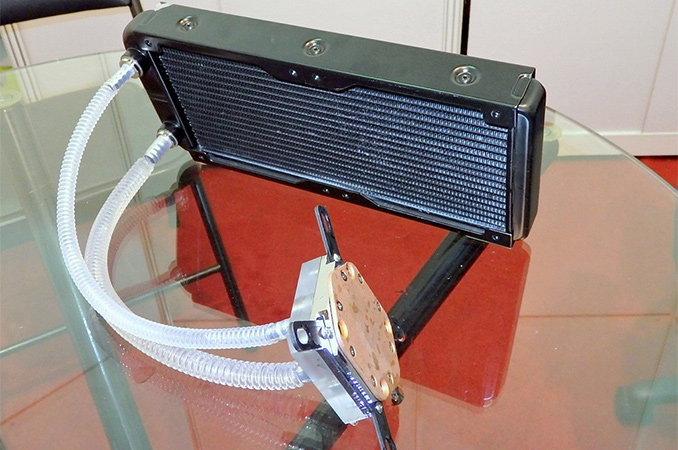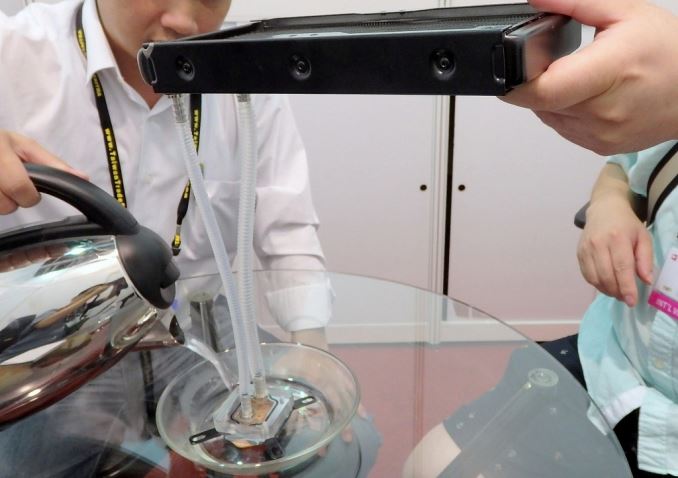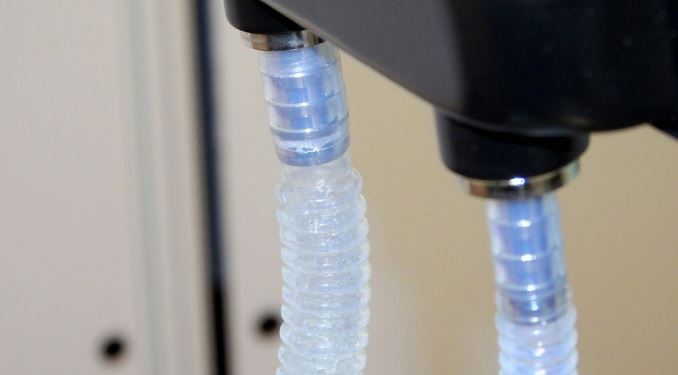Raijintek Shows Off Pumpless Liquid Cooling System
by Anton Shilov on June 3, 2016 10:00 AM EST
In the recent year’s all-in-one liquid cooling solutions gained significant popularity thanks to efficiency and quieter operation. However, even with those improvements, a closed loop cooler still needs a pump to enable circulation of liquid as well as at least one fan to maximize cooling efficiency. Seen as the next step, pumpless liquid cooling systems have been discussed by various developers for a while, and Raijintek demonstrated one at Computex 2016.
The prototype of Raijintek’s pumpless liquid cooling system is comprised of a completely passive CPU/GPU water block with a copper base (featuring a system of very thin channels to maximize heat dissipating surface area) with two nozzles of different diameter, two tubes as well as a radiator (images are by Hermitage Akihabara). The LCS is filled with a customized coolant, which has evaporation point of around 40°C to 50°C. Once the CPU or the GPU gets hot enough, the coolant turns into vapor and streams to the radiator through one of the tubes where it condenses back to liquid, whereas the cool coolant streams back to the water block.
Raijintek's prototype of a pumpless LCS. Image by Hermitage Akihabara.
Natural processes enable the circulation and the liquid cooling system is nearly noiseless (keep in mind that physical processes like water circulation create noises). In the best-case scenario, the higher is the temperature of the chip cooled down by such a LCS, the faster is the circulation. The theoretical limit of TDP that Raijintek’s prototype can handle is unclear, but different reports point to over 200 W, which is in line with traditional high-end and AIO liquid coolers. At Computex, the manufacturer demonstrated the prototype without any fans, but the radiator can be equipped with two of them to maximize cooling performance. While fans are not compulsory, there is a requirement, though: the radiator always has to be installed above the water block, which is something harder to do in small form-factor PCs.
Raijintek's prototype of a pumpless LCS. Image by Hermitage Akihabara.
The advantages of pumpless LCS are obvious: it does not have moving parts and therefore is more reliable than traditional systems; it does not generate as much noise and does not use power, provided that the coolant is cheap enough, the cost of a pumpless LCS should be lower than the cost of a traditional closed-loop liquid cooling system. On the other hand, it is completely unclear how the liquid with a very low evaporation point handles high TDPs when placed in a hot external environment. Besides, temperature of such liquid should remain below 40°C at all times (so, you are not going to use such device in Qatar, where temperatures above 40°C are common). Finally, the LCS must be perfectly sealed to maintain vacuum inside because any slight imbalance of pressure inside will harm its operation, a requirement that potentially increases the cost of the device.
Raijintek's prototype of a pumpless LCS. Image by Hermitage Akihabara.
Raijintek has invested a lot in development of its pumpless LCS over the years. In fact, the first prototype was ready back last year, but the company decided not to demonstrate it, but patent the technology in major markets first. Given the price of the new coolant as well as a new manufacturing process required to build pumpless LCS with vacuum inside, the price of the final product will not be low and may be actually higher compared to traditional AIO liquid coolers.
It is interesting to note that Raijintek is not the first to showcase a pumpless closed-loop liquid cooling system. Back in 2014, Silverstone demonstrated its prototype at Computex, but so far the company has not released it commercially.
Sources: BitTech, Hermitage Akihabara, TechPowerUp, 3DNews.













65 Comments
View All Comments
ipkh - Friday, June 3, 2016 - link
3M liquid has several options on boiling point.You needed an open system for the heat to escape. It was pump less in the sense that the entire system was under liquid, with all components contributing to boiling the liquid. It would rise a few centimeters above the liquid line, condense and fall back in. So you could effectively keep the entire system right at the boiling point of 40C. I think there was some very small loss per year.
A closed system might make sense given enough cooling. Not sure how it would work for side mounted systems.
JoeyJoJo123 - Friday, June 3, 2016 - link
Well, the liquid inside the AIO CLC kit needs to be filled to begin with, which provides a fixed cost that will increase the final cost of the end product. Then, the liquid inside AIO CLC kits does evaporate over time, depending on the tube seal and the tube's thickness. Additionally, some users buy AIO CLC kits to upgrade or use their own custom length tubing for their specific PC, refilling it with distilled water or some other coolant.Each situation doesn't bode well for an end consumer.
Murloc - Friday, June 3, 2016 - link
that kind of user buys a water block, not an AIO.Alexvrb - Saturday, June 4, 2016 - link
Right, because $50+ worth of coolant doesn't raise the cost of the end product. Whoops, there goes any cost advantage of ditching the pump (and then some). Talk about a niche market! Cost matters, and if they mass produce this you can bet they won't be using coolant that costs HALF that price.HomeworldFound - Friday, June 3, 2016 - link
You mean Fluorinert right?vanilla_gorilla - Friday, June 3, 2016 - link
Sooo ... is it weird the picture in this article is clearly cropped from the silverstone computex link?Anato - Friday, June 3, 2016 - link
If it needs near vacuum inside then this is just like heat pipes with flexible hoses. But wait... Most heat pipes work regardless of orientation, so this is actually worse.Is the "custom coolant" water in 12kPa (~0.12 atm) pressure?
saratoga4 - Friday, June 3, 2016 - link
This is in fact a type of heatpipe, although one that is gravity driven rather than capillary driven.keeepcool - Friday, June 3, 2016 - link
After cutting dozens of laptop heatpipes from models ranging from 0 to 5 years old, all the heatpipes are made the same way, a cooper tube half filed with cooper wax, no capillary anything, just cooper wax that melts around 40ºC and starts "flowing".saratoga4 - Friday, June 3, 2016 - link
They're made of copper, and the "wax" isn't a wax, it is a wick that provides the capillary action.